Module 2: Harvesting on Your Woodland
Lesson Four - Putting It All Together
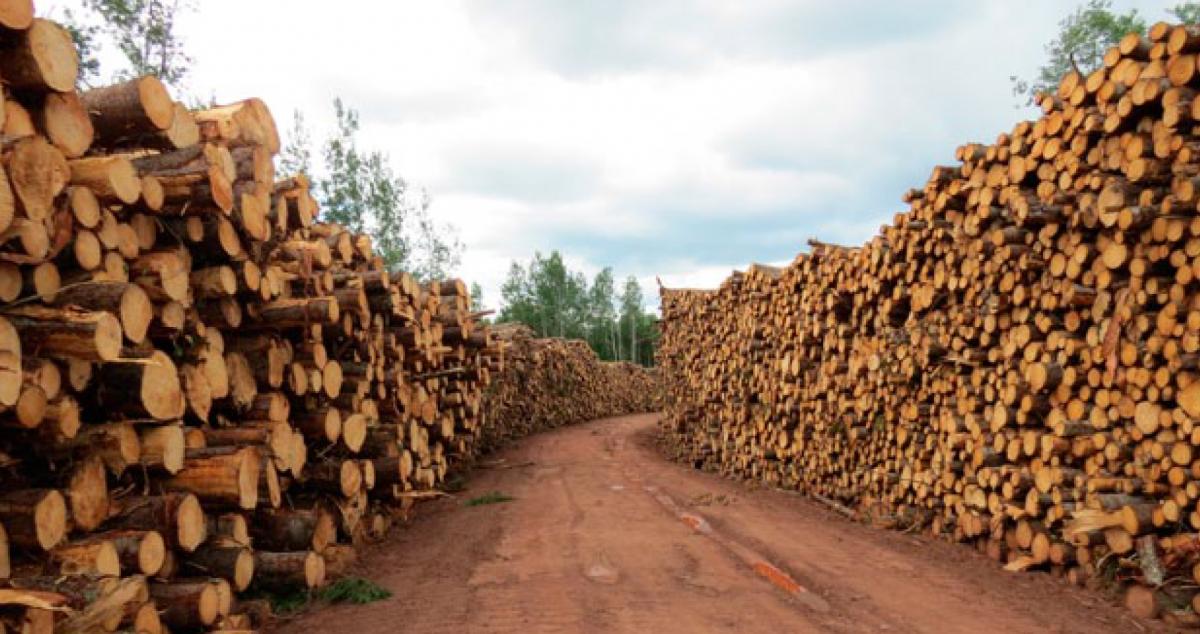 |
| Piles of cut-to-length wood ready for trucking. |
Harvesting is a silvicultural tool. It can be used to establish new regeneration or to release already- established seedlings and saplings. It can be used to create space for mature trees and to favour some species over others. Harvesting can be used to increase the quality of your woodland.
The choice of harvest prescriptions and harvesting systems requires careful consideration. Before you make a decision about harvesting a stand, you should use pre-treatment assessments to gather as many details as possible about the stand. How is the stand likely to regenerate? What is the soil texture and depth? Are the soils likely to be damaged during certain times of the year? What are the stand’s physical attributes (height, diameter, species and health)?
Harvesting Systems
In this module, four kinds of harvesting systems are discussed. The systems primarily differ from each other in the way the trees are harvested, the length to which they are cut, and how they are delivered to the side of the road. The systems are:
- Cut-to-length
- Random length
- Tree length
- Full tree and whole tree system
We will look at these harvesting systems individually.
Cut-to-length system
The name of this harvesting system indicates that wood is cut to pre-determined lengths. Mills require specific lengths for their products, and a good knowledge of each mill’s specifications is required. Trees are usually felled, de-limbed and cut to length at the stump. The wood is then picked up by extraction equipment, usually a forwarder, and transported to roadside.
Much of the cut-to-length wood that is harvested in Nova Scotia for pulpwood, studwood and firewood is between 2.44-meters (8-feet) and 2.75-meters (9-feet) in length. Softwood sawlogs are often cut into 3.66-m (12-ft), 4.27-m (14-ft) and 4.88-m (16-ft) lengths.
Cut-to-length wood is often easier to transport because all of the wood on a truckload is the same length.
Random-length system
In this harvesting system the trees are felled, de-limbed and cut once or twice to facilitate transportation of the wood, which varies in length. The wood is usually at least 3 meters in length, and can be extracted by skidder or forwarder. Once piled on a truck, the wood can be clearly seen to be of different lengths.
The wood is usually processed once it gets to the mill. Sawlogs and pulpwood are sorted from the pile and the remainder may be chipped for pulp or energy biomass.
Tree-length system
Wood that is felled, topped and de-limbed is called tree length wood. This wood is commonly 10-meters (30-feet) or more in length. It is usually dragged to roadside by skidder and trucked by semi-trailers.Like random-length wood, tree-length wood is cut-to-length at the mill, depending on product specifications. It can be sorted into several products such as sawlogs, pulpwood and energy biomass.
Full-tree and Whole-tree systems
Trees that are simply felled and transported to roadside are considered harvested with the full-tree system. Whole-tree harvesting includes also bringing the stumps to roadside, which is rarely – if ever – practiced in Nova Scotia forest management. The limbs are left on the trees until they are removed at roadside by a mechanical de-limber. The limbs, together with fine branches, needles and leaves, may be re-distributed over the harvested site to return nutrients to the soil, or they may be chipped or mulched into energy biomass and trucked. The main stem of the tree is chipped on-site or trucked to the mill for further processing.
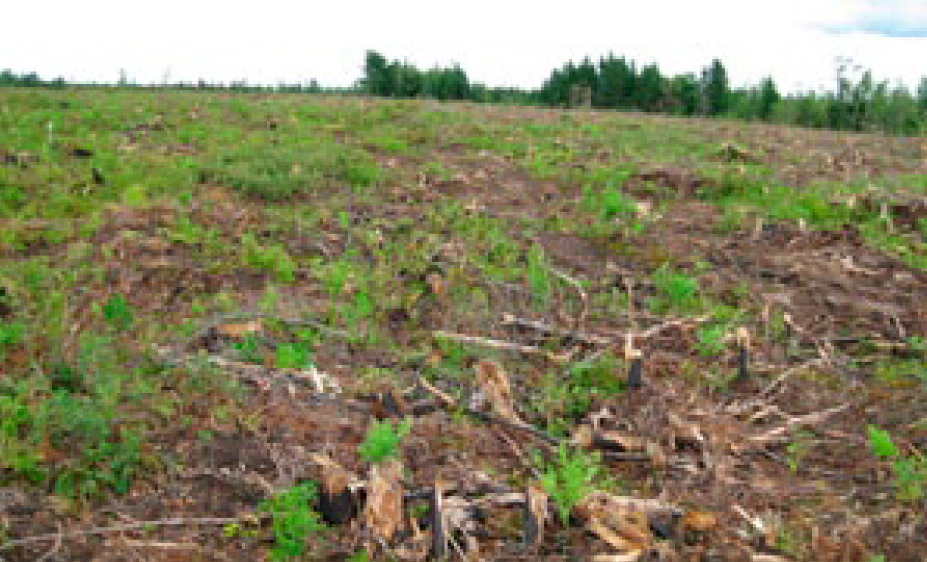 |
| A full-tree harvested site - Photo courtesy of NSDNR |
Detractors of the full-tree harvesting system indicate that the removal of the branches, twigs, needs and leaves and other material from the forest site depletes the soil of nutrients that are essential to healthy forest soils. This may be especially true on sites that may be no more than moderately productive. Full-tree and whole-tree harvesting systems are currently banned in Nova Scotia.
If you are harvesting your own wood, be sure to check with the mill to ensure that you are using the harvesting system that will allow you to maximize your revenue.
Harvesting Methods
Clearcutting
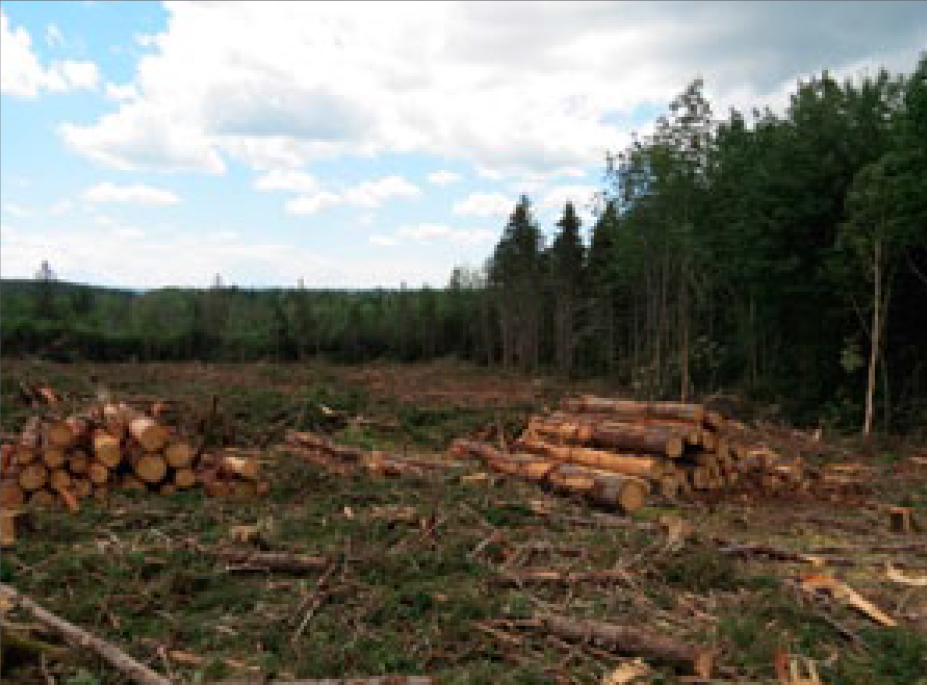 |
| A clearcut site |
Clearcutting is a stand-replacing harvesting practice that promotes and maintains an even-aged forest.
Most people are familiar with clearcutting as being the removal of most of the trees from a forest site. However, there are degrees to which trees can be removed, and in 2012 the Province of Nova Scotia defined a clearcut as: “…a forest harvest where less than 60 percent of the area is sufficiently occupied by trees taller than 1.3 meters.”
Stands that may be candidates for clearcutting include:
- Stands of old field white spruce that are mature and poorly rooted or have a high risk of blowdown.
- Stands of mature and overmature balsam fir in which there is adequate advanced regeneration.
- Stands that have been significantly damaged by insects, disease, fire or wind.
- Stands for which the landowner objectives include maximizing revenue.
When a site is clearcut, it regenerates to an even- aged stand. There may already be advanced regeneration present when the stand is cut, and the harvesting activity releases the regeneration into full sunlight. This is often a shock to the seedlings, particularly during warm sunny weather, and allowances should be made for losing a portion of the regeneration to this “burn-off” effect.
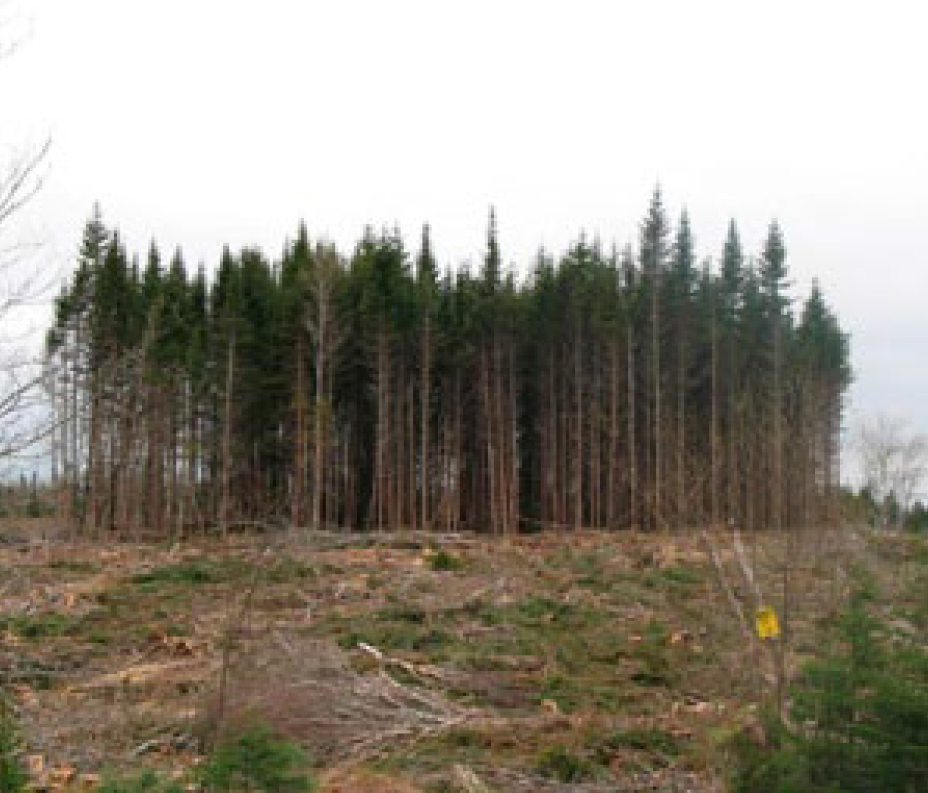 |
| Legacy/wildlife clumps must be left in larger clearcuts |
Selection Harvesting
During the past ten years there has been an increase in uneven-aged management on private woodlands in Nova Scotia through selection harvesting. The concept of uneven-aged management is not a new one: some woodlands have been maintained in an uneven-aged condition for generations. To many people it is regarded as an alternative to clearcutting, but it very much depends on the species- and age-structure of the forest in which you are working. Uneven-aged management can be carried out at either the stand- or woodland- level.
 |
|
Harvesting processor working in a selection harvest |
Some woodland owners prefer to retain a continuous forest canopy to protect the soil and regeneration from the drying effects of wind and sunlight, and from erosion during heavy rain. There may also be better opportunities to conserve habitat for some species of wildlife. Many woodland owners appreciate the visual appearance of selection harvesting since this harvesting method does not usually create large openings. Selection management also has the added advantage of maintaining a larger proportion of growing stock in higher-value trees, and it is not necessary to maintain as many young trees as in even-aged management. Good trees of higher value can be maintained as long as the owner wishes, since they do not need to be harvested all at once as with an even-aged system.
Uneven-aged management can be challenging for woodland owners who are used to even-aged management. It requires adequate planning and a good knowledge of the tree species, age structure and ground conditions of your woodland. And it is a flexible, dynamic, intensive method of managing your woodland, if the conditions are suitable.
It is important to get to know the ages of the trees on your woodland, particularly if you are considering selection management. Trees that seem different in height and diameter may be nearly the same age. This may be especially true if a woodland has been high-graded in the past, when only the largest and best trees were removed.
An uneven-aged stand contains at least three age classes of trees. Each age class is separated from others by 15 to 20 years, depending on tree species. A stand containing 80 year-old red spruce and hemlock, 50 year-old balsam fir and a mix of regeneration that is at least 30 cm in height, is an example of an uneven-aged stand.
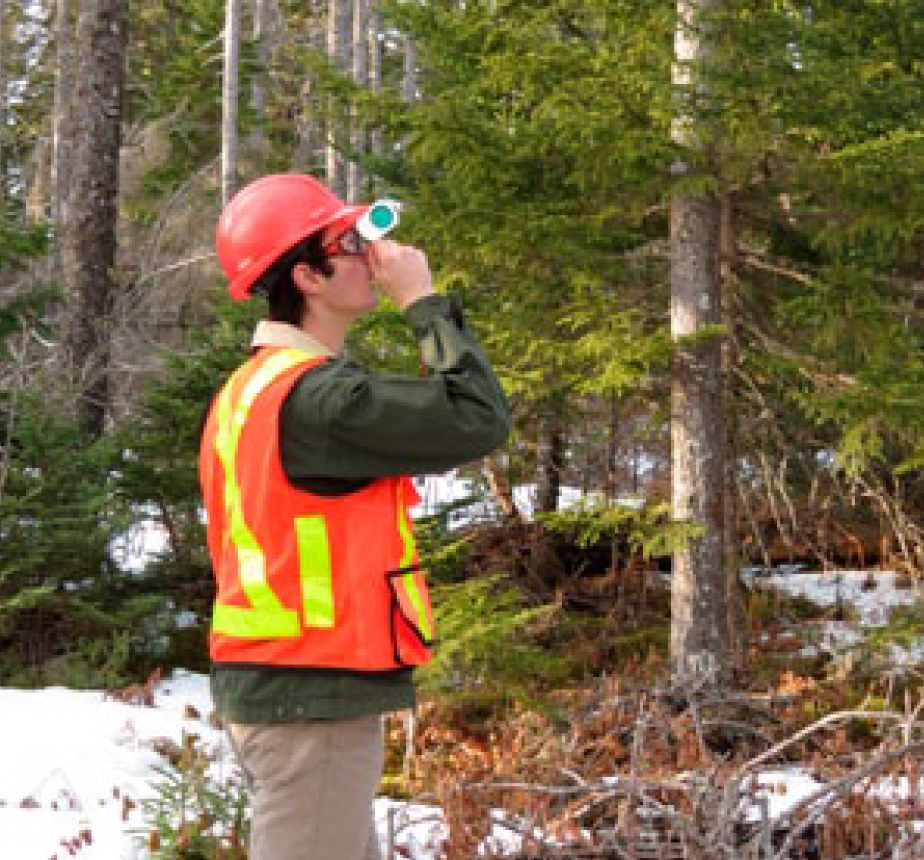 |
|
Checking tree heights in a selection harvest |
The best way to determine the approximate age of a tree is through the use of an increment borer, as discussed in Module 1 of this home-study series. Using the borer, a core sample can be taken from a tree and the growth rings counted. It should be noted that obtaining a core sample from hardwood trees can be difficult, and the ring count is not always reliable.
There are two types of selection harvesting: single- tree selection and group selection. The ways in which they maintain an uneven-aged forest condition are different, but the objective of both methods is the same: to maintain a permanent, but irregular cover over a forest area.
Single-tree selection
When individual trees are harvested throughout a stand or woodland, it is called single-tree selection. Done properly, this can be one of the most expensive types of harvest because of the high costs of wood extraction. If harvesting is to be done mechanically, trails will need to be cut to allow access by the processor and forwarder. These trails often regenerate aggressively after harvesting.
It is important to plan your selection harvesting carefully, particularly with the single-tree method. In some cases, trees are marked by forest professionals prior to cutting, which increases the chances of a successful treatment. During single- tree selection harvesting it is often tempting to cut only the largest and best quality trees for market. This poorly-informed process is called high- grading, and can leave woodlands in degraded condition. It is also termed selective harvesting.
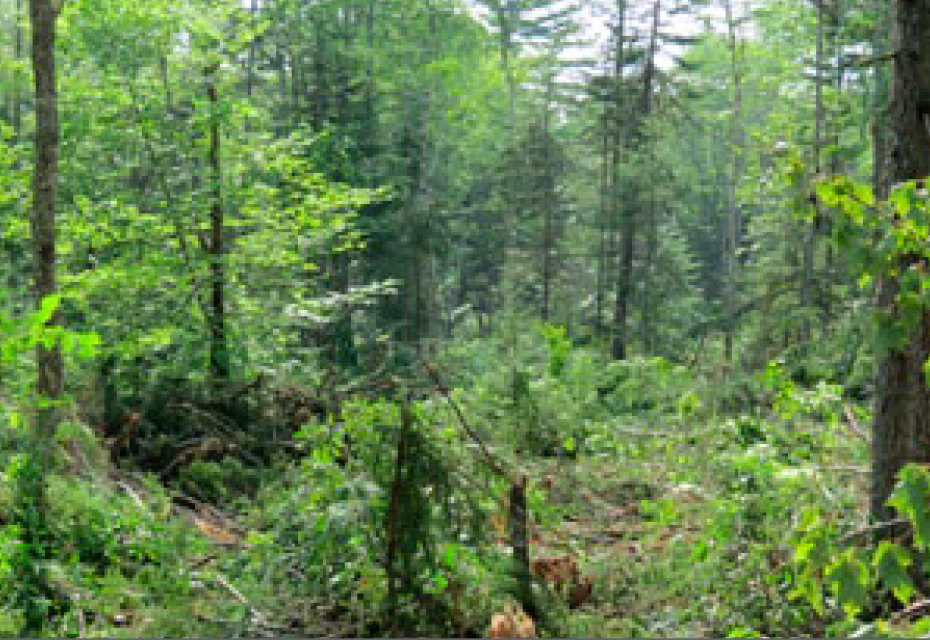 |
| Recently completed single-tree selection harvest |
Ideally, a proportion of trees of all sizes and ages are harvested during selection management, in order to maintain balanced age classes. If you are uncertain about how to proceed with a single-tree selection harvest, you should request assistance from a forest professional.
Many woodland owners carry out selection management on their own, using a chainsaw for felling and a farm tractor or skidder for extracting the wood. Horses and oxen can also be used. Skillful trail layout is important for efficient wood extraction.
Group Selection
A less expensive and popular uneven-aged management method is called group selection harvesting. Instead of harvesting trees throughout a stand or woodland, groups or clumps of trees are harvested, with extraction trails joining them. Once a group of trees has been harvested, the area is left to regenerate naturally. In some cases, fill planting may be necessary if regeneration is not satisfactory. Group selection is particularly successful in managing for high-quality hardwoods.
 |
| Completed group selection in hardwood |
The group selection method is an excellent way of ensuring that a woodland is never over-harvested. With careful planning and proper timing, small patches of trees can harvested at regular intervals. If your objective is to harvest trees at age 60 every five years, and if adequate regeneration is ensured, you could harvest one-twelfth of your forest area every five years under the group selection system. And because the harvesting work is concentrated in designated areas (preferably marked in advance), felling and extraction costs are reduced.
The frequency, size and shape of harvested patches can vary. If you are interested in promoting the regeneration and growth of mostly shade-tolerant tree species, patches should be no more than 30 meters in diameter. Such small openings allow partial shading over much of the harvested patch. Openings greater than 0.3-ha allows both shade-tolerant and shade-intolerant species to regenerate, and follow-up treatments such as manual weeding or pre-commercial thinning may be necessary to control unwanted vegetation.
Group selection mimics small-scale gap disturbances, with the resulting effect being the efficient establishment of natural regeneration within the harvested areas. As this type of harvesting is carried out over decades, newly regenerated areas will maintain the uneven-aged condition of the stand or woodland. As with single-tree selection harvesting, it is important to harvest all ages, sizes and quality of trees. Harvesting only the best trees will result in high-grading, or selective, harvesting.
Other Types of Harvesting Methods
Where wind-throw risk is minimal, partial harvests such as selection and shelterwood harvests can provide seed and shelter for shade-tolerant species. Seed-tree harvests, in which trees are left as seed “banks”, can be used to promote regeneration of Acadian Forest species.
Both small-gap and large-gap disturbances are common in the Acadian Forest. From individual trees that die and break off, or are windthrown, to entire forest stands, the Acadian Forest is full of irregularities and disturbances.
As a woodland owner, you can emulate these disturbances with partial harvesting.
Uniform Shelterwood Harvesting
Common on private woodlands 20 to 30 years ago, shelterwood harvesting is resurging as woodland owners see the benefits of establishing natural regeneration of long-lived, shade-tolerant species.
 |
| A successful softwood with good regeneration |
Shelterwood harvesting works best when carried out in stands of mature trees that have good genetic qualities and are capable of producing good seed crops. If no natural regeneration is present in the stand, a thinning of the overstory by removing the poorest-quality and least-desirable trees will allow sunlight to reach the forest floor. The sunlight will also reach the upper crowns of the seed trees, stimulating flower and seed production.
Once the seeds are germinated on the forest floor, the resulting seedlings will be protected from drying winds and full sunlight by the overstory trees. The partial shade will also discourage pioneer species such as aspen, gray birch and pin cherry from becoming established.
When the area s fully stocked with healthy regeneration the entire overstory - or some of it – can be removed. Care must be taken during felling and wood extraction to avoid damaging the regeneration and any residual trees. Both forwarders and skidders can be used effectively to extract wood from shelterwood harvests. On some woodlands, horses or oxen are used to bring harvested wood to roadside.
The primary risk in shelterwood harvesting – as it is in most forms of partial harvesting – is windthrow. Shelterwood harvesting should only be done on sheltered sites with well-drained, deep soils in which the trees are firmly rooted. For this reason, a pre-treatment assessment should be done on the site prior to prescribing this treatment.
For the most part, shelterwood harvesting results in even-aged stands which can be further managed to promote an uneven-aged structure should the landowner wish.
Seed-tree Harvesting
When it is anticipated that there will be little desirable regeneration following a clearcut harvest, leaving good seed trees scattered throughout the harvested site may be an option.
Choosing windfirm, seed-producing trees is critical to the success of this harvesting method. Ensure that the soils are deep and well-drained, and that the site is sheltered from prevailing winds.
It is important to keep in mind that there will not be enough coverage of seed trees to provide shade to discourage aggressive pioneer species, so expect plenty of shade-intolerant trees.
In most operations, the seed trees are left to form part of the new stand, and possess some legacy value. Good choices for seed trees are white pine, red spruce and red oak, although red spruce is most likely to break off or blow down soonest.
Some landowners recognize that most seed trees are likely to blow down, and are willing to sacrifice these trees to establish good natural regeneration.
It is important to properly plan a seed-tree harvest prior to clearcutting the site. Marking the seed trees in advance will ensure the retention of the best specimens.
Looking at the Landscape
Your woodland does not sit in isolation on the surrounding landscape. There may be several properties adjacent to yours, and each will have both similar and different characteristics in comparison to your woodland.
It can be challenging to think of large landscapes and where your woodland’s place is within it. A good way of seeing a bird’s-eye-view of your woodland in the landscape is to look at an aerial photo. You’ll see patterns repeated across the landscape. There may be dark patches of softwood stands, ridges of tolerant hardwoods, or boggy lowlands. You may see deeply cut valleys or river floodplains. Recognizing such patterns of ecosystems is central to ecological landscape classification.
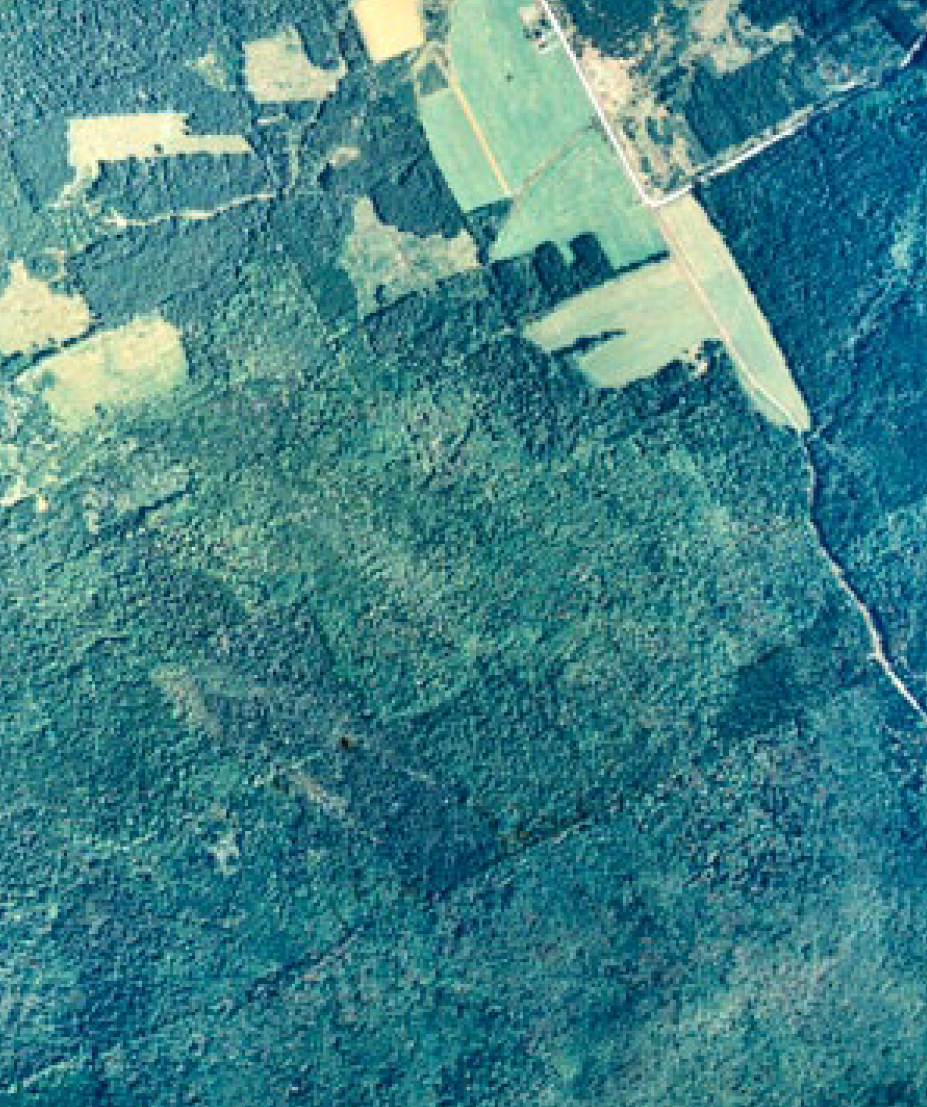 |
Vegetation types and soil types are similar on the landscape around your woodland. Natural disturbances such as spruce bark beetle or whitemarked tussock moth outbreaks are examples of landscape-level disturbances. The tussock moth may be infesting your trees, but it is likely infesting most of the woodland around you on a larger scale.
It is important to recognize that your woodland does not stand in isolation, and that activities on your property (such as harvesting) can affect the surrounding landscape.
Restoring Features of the Acadian Forest
The objectives of many woodland owners in Nova Scotia include the restoration of species and physical features of the Acadian Forest which were present in the province prior to land-clearing for European settlement.
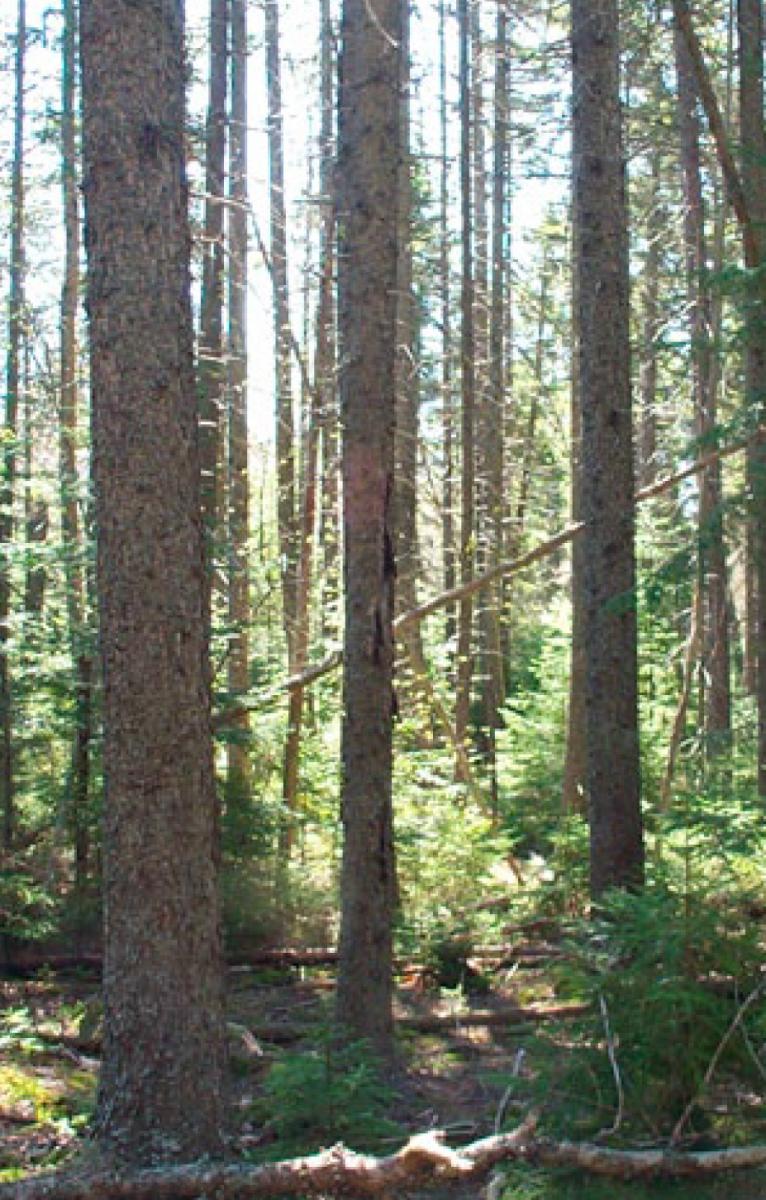 |
| A typical late-successional Acadian forest |
The Acadian Forest included a high proportion of mature to overmature trees of long-lived, intermediate and shade-tolerant species, including:
- Red spruce
- Black spruce
- Eastern hemlock
- White spruce
- White pine
- Balsam fir
- Sugar maple
- Yellow birch
- White ash
- Red oak
It is important to note that natural disturbances were present in the pre-European settlement period and there was also an abundance of fast-growing pioneer tree species that are associated with disturbance, including:
- Red maple
- Aspen
- White and gray birch
- Tamarack
- Pin cherry
In some stands, “restorative” harvests can be carried out which promote the regeneration and growth of Acadian Forest species. Selection harvests, shelterwood harvests and seed tree harvests can be used to increase the proportion of these species in a stand or woodland.
Some of these species may already be present in your woodland, even in areas that have been clearcut for several years. If you have an area that was clearcut 10-30 years ago, take a walk through the harvested site and look carefully. You may find some slower-growing Acadian Forest species just becoming established in the shade of the fast- growing pioneer species.
It should be noted that anticipated changes in climate lend some uncertainty to the future vegetation of what is now the Acadian Forest. In less than a century, other tree species may be better suited to the climatic conditions of some areas of Nova Scotia, while some species which are presently found in the province may be less abundant.
 |
| Patterns on the landscape Photo Courtesy NSDNR |
Case Study 2
Tom and Susan Fields had to make a decision soon. With one son entering college and a daughter not far behind, family expenses were about to rise dramatically.
The Fields’ woodland was finally beginning to show the results of good management. Tom and Susan had worked hard to make sure that the family woodland was in better shape than when they had purchased it 22 years ago. At that time it had been a 20-hectare (50-acre) clearcut which had been harvested 15 years previously. It had regenerated naturally to an even-aged stand of sugar maple, red maple, balsam fir and yellow birch. Scattered through the area were also a few hundred hemlock seedlings. Tom had spaced some of the densest thickets ten years ago, to give the trees more space and light. He noticed that, soon after, many of the small openings had seedlings present.
Now, at 37 years old, the hardwood trees were over 15-meters (45-feet) tall. It was easy to imagine that someday there would be a very large volume of good-quality wood growing on the woodland. Most of the best trees were sugar maple and yellow birch. Both Tom and Susan enjoyed visiting the woodland and were pleased with the growth of the trees.
One Saturday morning there was a knock at the Fields’ front door. The visitor was a logging contractor who made it clear that he would like to harvest the Fields woodland as soon as possible since, he indicated, the market for pulpwood was quite good. A lump-sum payment up front would make it easy for everyone, the contractor indicated.
 |
The offer seemed substantial. The contractor had offered to replant the site after harvesting. But the Fields had a nagging doubt.
The previous year the Fields had attended a field day on the property of the winner of the regional woodland owner of the year award. They remembered the horse-drawn hay ride through the woodland and the owner’s remarks that “sugar maple is my best and most valuable tree species because it makes wonderful sawlogs and will practically grow in the dark.” Tom and Susan marveled at the height and diameter of some of the trees, and asked the owner why he hadn’t yet cut them. “Those trees are like money in the bank,” the owner explained. “They gather interest as they accumulate wood volume, and also start new accounts by distributing good seed crops every few years. And,” he stated, “I know that those will be good seedlings because they came from my best trees.”
To Tom and Susan, it seemed like a common-sense approach, and they had not forgotten the reasoned, no-hurry demeanor of the woodland owner as he had explained that he cut some trees every year, both to make money and to make room for new trees.
Tom and Susan knew that they had a growing bank account on their woodland. They weren’t, however, sure that they wanted to cash it in right away. Besides, selling all their trees for pulpwood or firewood seemed to undermine their long-term objectives of maximizing their income from the woodland.
They quickly decided to turn down the offer to immediately harvest the woodland. Not surprisingly, the contractor offered an additional 10 percent, indicating that markets had since improved. This time, the Fields were blunt. “We’re looking for more long-term management,” stated Tom. “Well, don’t be surprised if the bugs eat your trees soon,” shot back the contractor as he left.
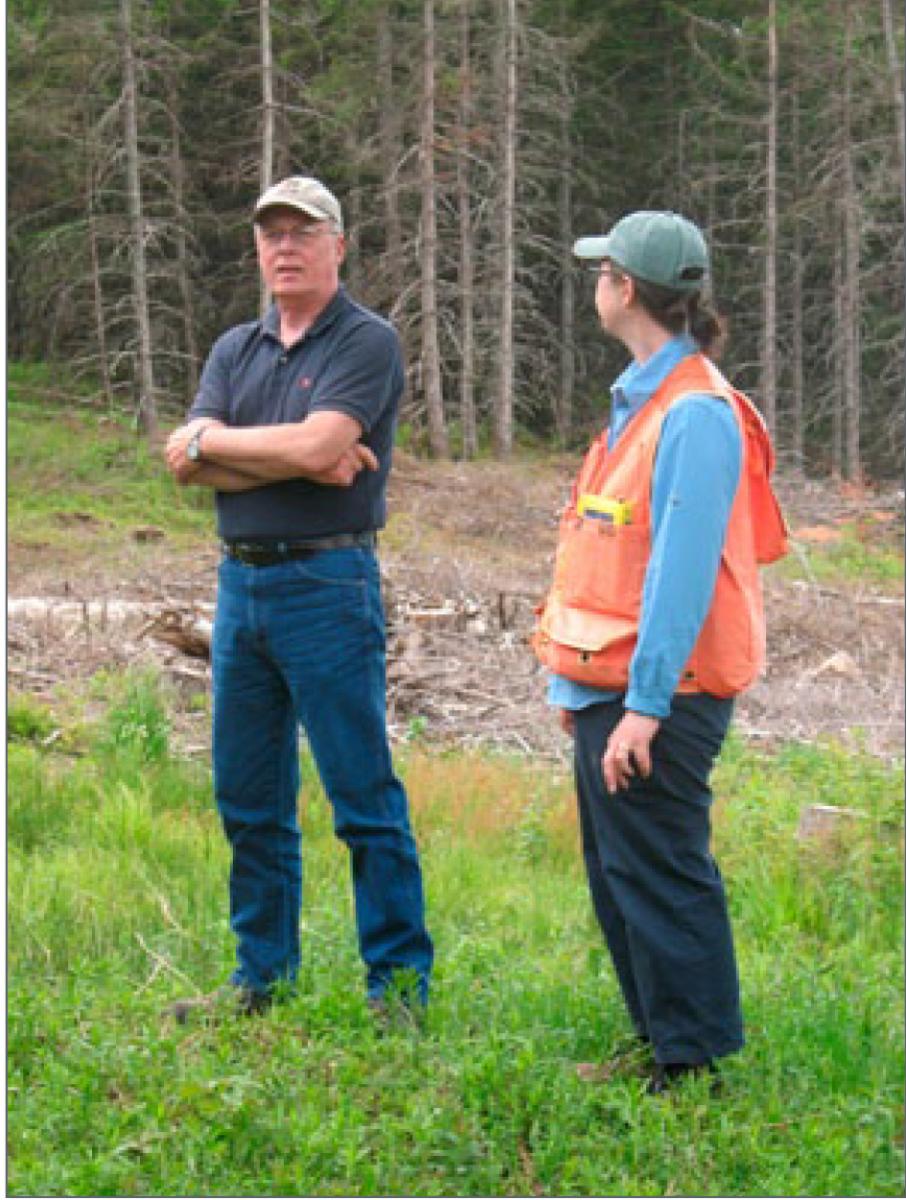 |
Within a few weeks of the contractor’s visit, another contractor visited the Fields, inquiring about purchasing their standing wood. Markets, he said, were good for pulpwood, but he did not want to cut all the trees. Instead, he would do another thinning, which would create small openings for new seedlings to become established. He would focus on removing the balsam fir and the poorest quality hardwood. He indicated that he had access to silviculture funding which would allow him to carry out good quality work without unduly impacting the value of the wood to the landowners.
The Fields felt that this sounded like a better idea than clearcutting their woodland, but were still undecided about what should be done next. A few days later they contacted a local forest professional, who recommended that a stewardship plan be the first step in their decision-making process. Tom and Susan agreed that this seemed like a logical way to proceed.
The landowners’ objectives were very important, stated the forester when she met with them to discuss their goals for the woodland a few days later. “We should be able to make this work,” Valerie stated as she showed them aerial photos of the woodland and surrounding countryside. From the photos the Fields could already see some differences in the patterns and colors within their woodland, and were surprised to see the variability that existed across their woodland. From the ground it looked much the same. From the air it was easy to spot clumps of hardwood and darker patches of fir.
They could even see a poorly-drained area near the center of the woodland, where the trees were shorter and yellow-green in color. “You’ll likely want to stay away from that wet site with heavy equipment,” said Valerie. She pointed to areas that she felt were worthy of special attention. “When I put your plan together, everything will be checked on the ground,” she said.
Within a couple of months, Valerie had the Fields’ stewardship plan completed. After examining the growth rings on the trees, she had concluded that it would be worthwhile to wait another five years before any of the trees were harvested. “They really haven’t begun to slow down yet because of overcrowding,” she said. “But as soon as they do, that’s the best time to thin.”
Valerie had also sampled the soil throughout the woodland and classified the forest ecosites. The results reinforced the validity of thinning on two areas, which covered over half of the woodland area. The soils were quite well-drained over most of the woodland, and had good structure for solid tree rooting.
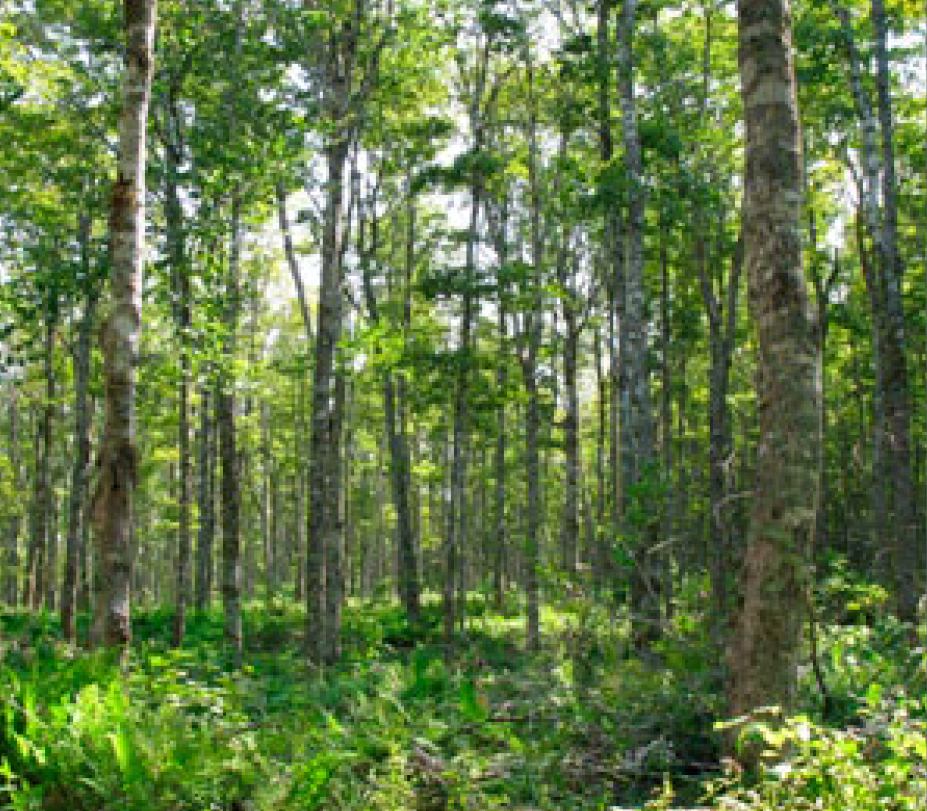 |
The Fields looked forward to thinning the woodland in a few years. It seemed like a progressive activity that would generate some income. Their anticipation was hard to contain.
Five years later, the Fields contacted Valerie, asking whether she would once again look at the trees on their property. From several outings on their woodland, Tom and Susan knew that the trees had grown at least another three meters (10-feet) in height. Valerie seemed impressed with the growth of the trees and indicated that – if treated just right – these even-aged stands could perhaps be converted to uneven-aged stands. She explained that if the Fields were interested in smaller – but more frequent – income, uneven-aged management might suit their objectives.
Securing funding for the thinning was not an issue. A provincial government agency provided silviculture assistance for small private woodlands and could help offset the cost of thinning. A local contractor specialized in commercial thinning and was hired to do the job. His small-scale harvester and forwarder were perfect for felling trees and extracting the wood without damaging the remaining trees. The contractor removed about one-third of the trees on the two sites that were thinned. With one of the Fields’ daughters entering university, the stumpage payment for the thinning had been timely indeed.
The Fields were a little concerned that the thinned areas of their woodland would suffer the same fate as the “beauty strips” they had noticed along the sides of the highway next to clearcuts. They hoped that within a few years the trees were not flattened by wind.
Over the next 20 years their fears faded. The presence of two hurricanes had made them anxious, but Valerie’s previous site work had confirmed that the two stands of thinned trees should be windfirm.
The Fields noticed something else. Where the thinning had been completed, there was an abundance of younger trees growing in the openings. The sizes of these trees ranged from tiny seedlings to wiry poles over five meters in height, and there was a mixture of softwood and hardwood regeneration: balsam fir mingled with sugar maple and white ash. Valerie had been right – these two stands, treated appropriately, now had an uneven-aged structure.
There were now trees of all sizes and ages throughout Tom and Susan’s woodland. In the thinned areas, the age difference was remarkable. Fifty-year-old sugar maple trees sheltered young ash seedlings, and patches of balsam fir carpeted the larger openings. Sugar maple saplings were scattered among the taller trees. The Fields were pleased to see this mixture of hardwood and softwood species among the regeneration.
The Fields had noticed something else. As the trees had aged on their woodland, so they too were aging. Now close to retirement, it was time to consider more harvesting to help supplement their savings. Valerie had moved west to find employment, so they contacted their local woodland association for help. Before long Peter, a forest technician, had visited their woodland, updated their stewardship plan and had made some recommendations for harvesting, which the Fields were ready to hear.
“Selection management is a harvesting method which can promote natural regeneration, increase growth on your best crop trees, and harvest the trees that are ready for market,” explained Peter. Trees are cut throughout your woodland, always ensuring that good growing stock is left. This can be done by harvesting patches, or by harvesting individual trees.” The Fields liked this idea, and although they were tempted to harvest individual trees for the visual appeal, Peter explained that cutting patches, or group selection, was cheaper and would likely yield a better return. “And it maintains the uneven-aged structure of the woodland,” he added.
Peter contacted a harvesting contractor, who arrived at the Fields’ woodland about a month later. The harvesting equipment, floated in by a low-bed tractor-trailer, was smaller than most of the other harvesters and forwarders that Tom and Susan had seen working nearby. Although both machines had rubber wheels, these were covered by tracks. The contractor was able to use most of the roads and trails that were built during the thinning. Although these had many young trees growing in them, Peter assured the Fields that this was not a concern, and that there were plenty of other small trees growing throughout the woodland.
 |
Tom and Susan were amazed at the piles of wood that were soon growing by the side of the road. With for different products, the contractor was carefully sorting the wood for its highest value. The very best logs would be sawn for timber-frame homes, which had resurged as an in-vogue dwelling design. The other wood was sold for traditional building lumber and decorative wood fencing. The Fields were impressed with the contractor’s ingenuity in sourcing local markets, keeping transportation costs down.
When the contractor left and the last piece of wood was trucked away, the Fields walked through their woodland. They saw where the contractor had cut trails to access small patches of wood, leaving everything else intact. Susan gasped as a doe and two fawns walked slowly and deliberately through one of the harvested patches, stopping briefly to gaze at the woodland owners. A pileated woodpecker started hammering on a nearby tree, looking for insects.
 |
As they walked they were pleased with the small amount of soil disturbance and the feeling that were still very much surrounded by their woodland. Nearly one-third of the wood volume on their woodland had been harvested, but it felt like much less. There were still trees of all sizes, from seedlings to mature trees. There were still excellent trees remaining for seed production. Tom and Susan were sure that the harvested patches would be thickets of trees within a decade.
What perhaps pleased them most was the fact that they were going to be passing this woodland to the next generation, and it was a fine example of good forest management. They had cared for it over the decades, asking questions of professionals when they weren’t sure of the answers, and making sure that planning was an important prerequisite. Above all, Tom and Susan were pleased that they had been patient. They learned that the real benefits of woodland stewardship grew slowly, but were worth the wait.
CONCLUSION
It is apparent to you by now that any decision to harvest your woodland should not be taken lightly. This module has offered advice on how to proceed with your decision-making, and has underlined the vital importance of proper planning. Ideally, you should have a woodland stewardship plan – the basics of which is outlined in Module 1A – that will have far-reaching and important continuity throughout the management of your woodland.
Your goals will reflect where you may wish to harvest on your woodland, and how much should be harvested. This module reviewed the many values that woodland owners have, and many of these values may be more important than income from wood products. You have also seen how harvesting can provide a source of income to those landowners who plan for this objective.
If you plan to harvest, be observant. See what the site can tell you. The use of Forest Ecosystem
Classification can go a long way in helping you reach a decision. This module has indicated that you should carefully assess the species, age, health, presence of regeneration and windfirmness of a stand prior to making any harvest decision. You should also determine if the soil conditions will withstand heavy equipment, if it is to be used.
Pay attention to detail, but don’t become bogged down in it. Sometimes the larger view is a better one, particularly if you can see your woodland, and yourself, on the landscape. Above all, don’t limit your choice of harvest method to those you’ve reviewed in this module. Often, combinations of systems work well. Let your woodland tell you what is best.
Talk with other woodland owners who have experience with harvesting: they are your best source of information. Go to woodland field days. See what others are doing, and you’ll see what works. Seek out the advice of a forest professional, and above all, have fun! Owning woodland is an exciting adventure!
